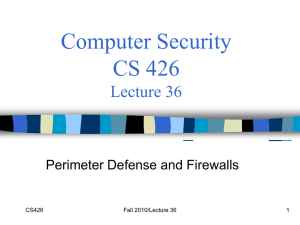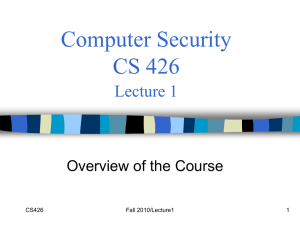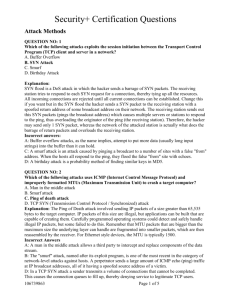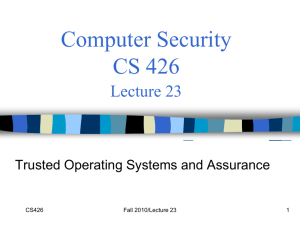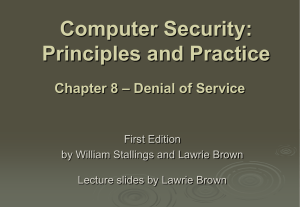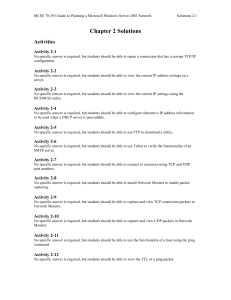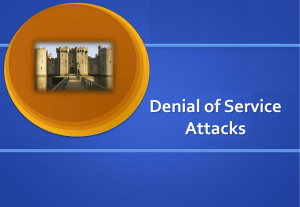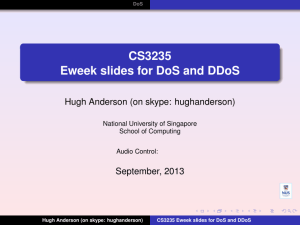Network Security
advertisement
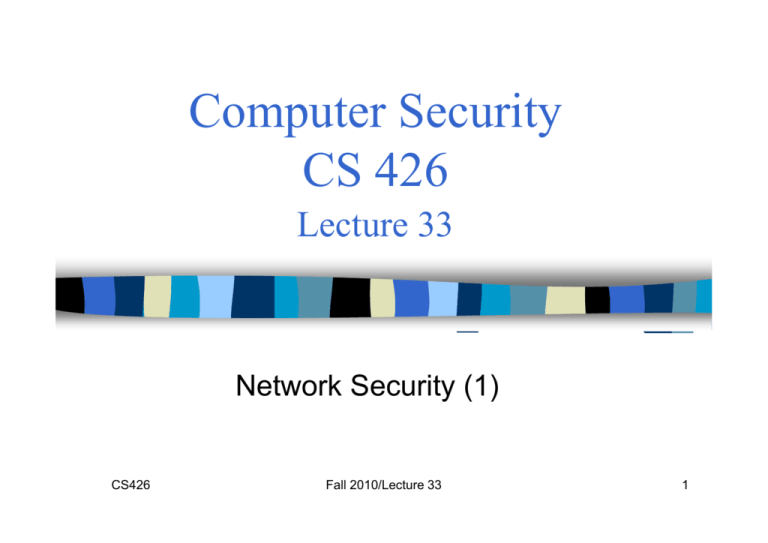
Computer Security CS 426 Lecture 33 Network Security (1) CS426 Fall 2010/Lecture 33 1 Network Protocols Stack Application Application protocol TCP protocol Transport p Application Transport p Network IP protocol IP IP protocol Network Link Data Link Network Access Data Link Link CS426 Fall 2010/Lecture 33 2 Types yp of Addresses in Internet • Media Access Control (MAC) addresses in the network access layer – Associated w/ network interface card (NIC) – 48 bits or 64 bits • IP addresses for the network layer y – 32 bits for IPv4, and 128 bits for IPv6 – E.g., 128.3.23.3 • IP addresses + ports for the transport layer – E.g., 128.3.23.3:80 • Domain names for the application/human layer – E.g., www.purdue.edu CS426 Fall 2010/Lecture 33 3 Routing and Translation of Addresses • T Translation l ti b between t IP addresses dd and d MAC addresses – Address Resolution Protocol (ARP) ( ) for f IPv4 – Neighbor Discovery Protocol (NDP) for IPv6 • Routing with IP addresses – TCP, UDP, IP for routing packets, connections – Border Gateway Protocol for routing table updates • Translation between IP addresses and domain names – Domain o a Name a e Syste System ((DNS) S) CS426 Fall 2010/Lecture 33 4 Threats in Networking g • Confidentiality C fid ti lit – Packet sniffing • Integrity – Session hijacking • Availability – Denial of service attacks • Common – Address translation poisoning attacks – Routing attacks CS426 Fall 2010/Lecture 33 5 Concrete Security y Problems • ARP iis nott authenticated th ti t d – APR spoofing (or ARP poisoning) • Network packets pass by untrusted hosts – Packet sniffing • TCP state can be easy to guess – TCP spoofing p g attack • Open access – Vulnerable to DoS attacks • DNS is not authenticated – DNS poisoning i i attacks tt k CS426 Fall 2010/Lecture 33 6 Address Resolution Protocol (ARP) ( ) • Primarily used to translate IP addresses to Ethernet MAC addresses – The device drive for Ethernet NIC needs to do this to send a packet • Also used for IP over other LAN technologies, e.g., FDDI, or IEEE 802.11 • Each host maintains a table of IP to MAC addresses • Message types: – ARP request – ARP reply – ARP announcement CS426 Fall 2010/Lecture 33 7 http://www.netrino.com/Embedded-Systems/How-To/ARP-RARP CS426 Fall 2010/Lecture 33 8 ARP Spoofing p g (ARP ( Poisoning) g) • Send fake or 'spoofed' 'spoofed', ARP messages to an Ethernet LAN. – To have other machines associate IP addresses with the attacker’s MAC • Defenses – static ARP table – DHCP snooping (use access control to ensure that hosts only use the IP addresses assigned to them them, and that only authorized DHCP servers are accessible). – detection: Arpwatch (sending email when updates occur), • Legitimate use – redirect a user to a registration page before allow usage of the network t k CS426 Fall 2010/Lecture 33 9 IP Internet Protocol Version • Connectionless C ti l – Unreliable – Best effort Flags Fragment Offset Time to Live Protocol Header Checksum • Transfer datagram – Header – Data Header Length Type of Service T t l Length Total L th Identification Source Address of Originating Host Destination Address of Target Host Options P ddi Padding IP Data CS426 Fall 2010/Lecture 33 10 IP Routing g Meg Office gateway Packet 121.42.33.12 121 42 33 12 Source 121.42.33.12 Destination 132.14.11.51 5 Sequence Tom 132 14 11 1 132.14.11.1 ISP 132 14 11 51 132.14.11.51 121.42.33.1 • Internet routing uses numeric IP address • Typical route uses several hops CS426 Fall 2010/Lecture 33 11 Packet Sniffing g • Promiscuous Network Interface Card reads all packets – Read all unencrypted yp data ((e.g., g , “ngrep”) g p) – ftp, telnet send passwords in clear! Eve Alice Network P Prevention: ti E Encryption ti CS426 Bob (IPSEC TLS) (IPSEC, Fall 2010/Lecture 33 12 User Datagram g Protocol • IP provides id routing ti – IP address gets datagram to a specific machine • UDP separates traffic by port (16-bit number) – Destination port number gets UDP datagram to particular application process, e.g., 128.3.23.3:53 – Source port number provides return address • Minimal guarantees – No acknowledgment – No flow control – No message g continuation CS426 Fall 2010/Lecture 33 13 Transmission Control Protocol • Connection-oriented, preserves order – Sender • Break data into packets • Attach sequence numbers – Receiver • Acknowledge receipt; lost packets are resent • Reassemble packets in correct order Book Mail each page Reassemble book 1 19 5 1 CS426 Fall 2010/Lecture 33 1 14 TCP Sequence q Numbers • Sequence number (32 bits) – has a dual role: – If the SYN flag is set, then this is the initial sequence number. The sequence q number of the actual first data byte y is this sequence number plus 1. – If the SYN flag is clear, then this is the accumulated sequence number of the first data byte of this packet for the current session session. • Acknowledgment number (32 bits) – – If the ACK flag is set then this the next sequence number that the receiver is expecting. – This acknowledges receipt of all prior bytes (if any). CS426 Fall 2010/Lecture 33 15 TCP Handshake C S SYN (seq=x) Listening Store data SYN ACK (ack (ack=x+1 x+1 seq seq=y) y) ACK (ack=y+1,seq=x+1) CS426 Fall 2010/Lecture 33 Wait Connected 16 TCP sequence q p prediction attack • Predict the sequence number used to identify the packets in a TCP connection, and then counterfeit packets. • Adversary: do not have full control over the network network, but can inject packets with fake source IP addresses – E.g., g , control a computer p on the local network • TCP sequence numbers are used for authenticating packets • Initial seq# needs high degree of unpredictability – If attacker knows initial seq # and amount of traffic sent, can estimate likely current values – Some implementations are vulnerable CS426 Fall 2010/Lecture 33 17 Blind TCP Session Hijacking j g • A, B trusted connection Server A – Send packets with predictable seq numbers • E impersonates B to A E B – Opens Ope s connection co ect o to A to get initial ta seq number – DoS B’s queue – Sends S d packets k to A that h resemble bl B’s transmission – E cannot receive,, but mayy execute commands on A Attack can be blocked if E is outside firewall. firewall CS426 Fall 2010/Lecture 33 18 Risks from Session Hijacking j g • Inject data into an unencrypted server server-to-server to server traffic traffic, such as an e-mail exchange, DNS zone transfers, etc. • Inject j data into an unencrypted yp client-to-server traffic,, such as ftp file downloads, http responses. • IP addresses often used for preliminary checks on fi firewalls ll or att th the service i llevel. l • Hide origin of malicious attacks. • Carry out MITM attacks on weak cryptographic protocols protocols. – often result in warnings to users that get ignored • Denial of service attacks, such as resetting the connection. CS426 Fall 2010/Lecture 33 19 DoS vulnerability caused by session hijacking • S Suppose attacker tt k can guess seq. number b for f an existing connection: – Attacker can send Reset packet to close connection. Results in DoS. – Naively, N i l success prob. b iis 1/232 (32-bit (32 bit seq. #’ #’s). ) – Most systems allow for a large window of acceptable seq seq. #’s #s • Much higher success probability. • Attack is most effective against long lived connections, e.g. BGP. CS426 Fall 2010/Lecture 33 20 Categories of Denial-of-service Attacks Stopping services Exhausting resources • Process killing • Spawning processes to fill the process table Locally • Process crashing • System reconfiguration • Filling up the whole file system fil • Saturate comm b d idth bandwidth • Malformed packets to • Packet floods (Smurf SYN flood (Smurf, flood, Remotely R t l crash buggy services DDoS, etc) CS426 Fall 2010/Lecture 33 21 SYN Flooding g C S SYNC1 SYNC2 SYNC3 Listening Store data SYNC4 SYNC5 CS426 Fall 2010/Lecture 33 22 SYN Flooding g • Attacker sends many connection requests – Spoofed source addresses • Victim allocates resources for each request – Connection requests exist until timeout – Old implementations have a small and fixed bound on half-open connections • Resources exhausted requests rejected • No more effective than other channel capacity capacitybased attack today CS426 Fall 2010/Lecture 33 23 Smurf DoS Attack 1 ICMP Echo Req Src: Dos Target Dest: brdct addr DoS Source 3 ICMP Echo Reply Dest: Dos Target gateway DoS Target • S Send d ping i requestt tto broadcast b d t addr dd (ICMP E Echo h R Req)) • Lots of responses: – E Every h hostt on target t t network t k generates t a ping i reply l (ICMP Echo Reply) to victim – Ping g reply p y stream can overload victim Prevention: reject external packets to broadcast address CS426 Fall 2010/Lecture 33 24 Internet Control Message g Protocol • Provides feedback about network operation – Error reporting – Reachability testing – Congestion Control • Example message types – – – – – – CS426 Destination unreachable Time-to-live Time to live exceeded Parameter problem Redirect to better gateway Echo/echo reply - reachability test Timestamp request/reply - measure transit delay Fall 2010/Lecture 33 25 Distributed DoS (DDoS) ( ) CS426 Fall 2010/Lecture 33 26 Hiding g DDoS Attacks • Reflection R fl ti – Find big sites with lots of resources, send packets with spoofed source so rce address address, response to victim ictim • PING => PING response • SYN => SYN-ACK SYN ACK • Pulsing zombie floods – each h zombie bi active ti b briefly, i fl th then goes d dormant; t – zombies taking turns attacking – making tracing difficult ff CS426 Fall 2010/Lecture 33 27 Cryptographic yp g p network protection p • Solutions above the transport layer – Examples: SSL and SSH – Protect against session hijacking and injected data – Do not protect against denial-of-service attacks caused by spoofed packets • Solutions at network layer – Use cryptographically random ISNs [RFC 1948] – More M generally: ll IP IPsec – Can protect against • session hijacking and injection of data • denial-of-service attacks using session resets CS426 Fall 2010/Lecture 33 28 Readings g for This Lecture • Optional Reading • Steve Bellovin: A Look Back at “S “Security it P Problems bl iin th the TCP/IP Protocol Suite” CS426 Fall 2010/Lecture 33 29 Coming g Attractions … • DNS S Security it CS426 Fall 2010/Lecture 33 30
